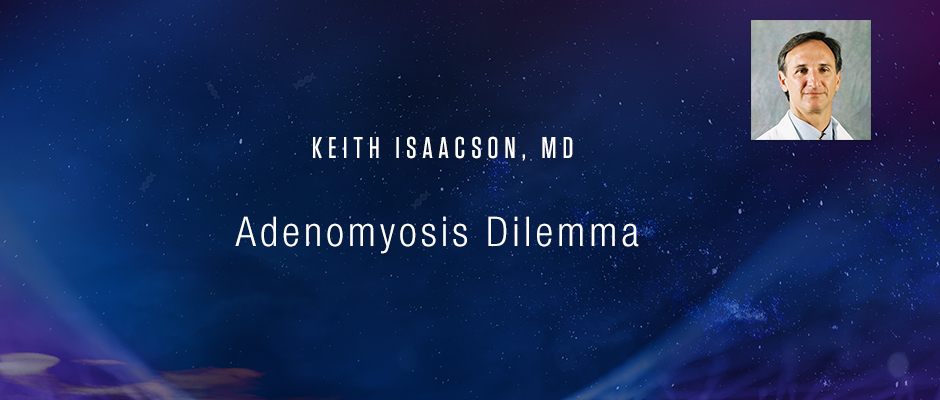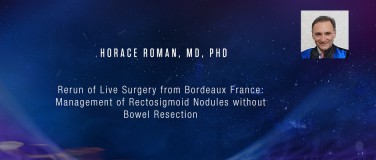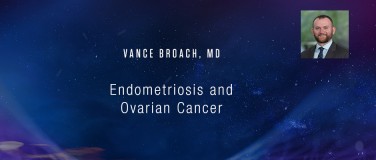Keith Isaacson, MD - Adenomyosis Dilemma
Endometriosis Foundation of America
Medical Conference 2019
Targeting Inflammation:
From Biomarkers to Precision Surgery
March 8-9, 2019 - Lenox Hill Hospital, NYC
https://www.endofound.org/medicalconference/2019
Tamer, thank you very much for inviting me to come. It doesn't work on the slideshow, so I'll show it like this. It's an honor and a privilege to be here amongst, again, the stars in our field. I'm hoping that in about five years when we have this conference, it'll be the endometriosis actually no. It should be the adenomyosis and endometriosis conference instead of just the endometriosis conference because I think we've really missed the boat on adenomyosis, and I'm gonna tell you why over the next 20 minutes. Tom gave me the title adenomyosis dilemma. Boy, as far as a dilemma, this is adenomyosis really fits the title.
My disclosures are that I'm a consultant for Karl Storz Endoscopy and Medtronics but those are on histoscopic equipment and doesn't affect this particular talk. Why is adenomyosis so hard to understand? Well, its variation and symptoms. We have no standardized histologic definition. We have no standardized radiologic definition. The diagnosis is most often made without a tissue diagnosis. If you don't have a tissue, that's gonna influence your incidence, your prevalence, and risk factors. We have no standard classification of the disease, so it's hard for us to communicate with each other as to what stage one, two, three, or four diseases. It's all descriptive.
I know that Dr. Griffith talked about yesterday, there's actually a paucity of research in adenomyosis in a condition that probably affects 15% of all women. It presents with abnormal, heavy bleeding, dysmenorrhea, back pain, dyspareunia, and infertility. What's key for us now is that we have to now be cognizant of the disease. We have to be suspicious when patients come in and present with those symptoms that adenomyosis is a real possibility, as a cause of their disease. Our problem has been, over the last 30 years, is that we treat what we can see. If we can't see it, then we assume it's not there and we're treating something else. I was struck this morning when Dr. Redwine said, "I have resect disease for the last 40 years or 50 years," however old you are, David, 60 years.
Yet, we don't do very well with dysmenorrhea. We never really thought about why that is. Now, with the advent of trans-vaginal ultrasound and helping us make the diagnosis of adenomyosis, we're really finding the disease in people we never thought had it. Again, you can't really use MRIs. It's good screening tool, but MRI is a good way to diagnose adenomyosis. You see a thickening of the junctional zone. That's very obvious of right here. Now, over the last three or four years, led by people such as Caterina Exacoustos, we're just as accurate to make the diagnosis of adenomyosis or changes consistent with adenomyosis I would say, just by transactional ultrasound. It's so easy.
All we're really looking for, in this particular, this is the same patient. You can see a retroverted uterus. You can see a thickened posterior, myometrium. It turns out to be a disease in the posterior aspects 70% of the time. You can see cystic lesions. There are other changes that you can find in patients with adenomyosis, which include kind of hockey stick in the myometrium, changing the vascularity. You can actually see the junctional ozone on 3D ultrasound. It is accurate in picking up and adenomyosis about 90% of the time. Now, we are currently with adenomyosis, where we were back with endometriosis in the 1970s, when many of the surgeons in here started practicing.
In the 1970s, this is what V.C. Buttram, who was a leader in the field out of Texas in 1979. He wrote this about patients who had endometriosis. He said, "Typically our patients with endometriosis appear to have an intense desire to excel. They are intense perfectionist, demanding in specific goals. They're usually well-dressed and have trimmed figures. Most are employed as secretarial positions, professions and law, medicine, and teaching. Once aware of an infertility problem, many patients have an obsessive desire to conceive. The point was, who was getting diagnosed back then? People, not everyone had the availability of laparoscopic procedures. My suspicion is these are the patients who most likely got the laparoscopy. Therefore, we thought those were the ones at high-risk for the disease.
We now know, and this is a slide from Linda, which includes Linda. You probably saw it yesterday. That endometriosis is not a disease necessarily of well-dressed, white women in secretarial positions. That there is heterogeneity and age of onset symptoms, drug responses, comorbidities and what have you. We know that the disease takes on many forms. What's the clinical presentation of endometriosis? 50 to 90% of the patients have dysmenorrhea. They have dyspareunia. They have deep pelvic pain. They have low abdominal pain and back pain. They have cyclic bowel and bladder symptoms, and they have infertility. Essentially, any of these symptoms that intensify with the menstrual cycle thought to be due to endometriosis. Now, I want you to tell me how these lesions here, which we know, and we heard again this morning, that this stage of the disease does not correlate with the severity of the symptoms. You tell me how these lesions here and these clear vesicles here caused dysmenorrhea? Tell me how they cause dyspareunia.
Tell me how they cause abnormal uterine bleeding or having menstrual bleeding. Tell me how they cause infertility. Well, I can tell you with adenomyosis, if we just focus on in infertility, that there's good data now. That was published by Tolandi in The Fertility and Sterility. The patients with adenomyosis actually have lower implantation rates for undergoing IVF. They have lower clinical pregnancy rates if they're undergoing IVF, and they have lower live birth rates, if they have adenomyosis. It's actually a 41% decrease in the live birth rate. This has not has nothing to do with the endometriosis at all. It's a uterine disease.
Now, I want you to think about adolescents. Adolescents now are probably the ones who are the most vulnerable to this misdiagnosis because 15%, which is a huge number, 15% of adolescence missed at least one day a month from school because of severe painful periods. As Dan Martin said, "We don't tell these people it's normal to have that severe of painful periods." When they go in and they have a laparoscopy, they see these clear lesions. Many times, those clear lesions are not even biopsied. The patients are told they have endometriosis. Then they're put on the birth control pill, or they're put on Mirena. They're given some hormonal therapy, and told that's what's causing their severe dysmenorrhea, never having an ultrasound to look for other causes.
We know that 92% of these patients have stage one or stage two disease. There's a 56% recurrence of symptoms even if you resect it within five years. This is a 17-year-old patient who came to my office. We did a trans-vaginal ultrasound, which I met in a younger patient can be difficult, but she happened to be sexually active. You can see in the posterior wall, in this patient, you can see cystic adenomyosis. I would say that if you think about it, is she had severe dysmenorrhea. It makes sense that she's going to have a uterine disease. You have to think about it. Often, if you ask them, they will have heavier than normal periods. If they're sexually active, they'll often have dyspareunia. It's not just the younger patients. This is a study published by Francisco Carmona looked at 155 women who had deep infiltrating endometriosis, and also had adenomyosis.
There was a positive correlation of endometriosis to pelvic pain, rectal bleeding, dysuria and hematuria, and not a positive correlation with the deep infiltrating endometriosis in this particular study. I say when you think about the risk factors for adenomyosis, what are we taught? We're taught it happens to women in their 40s. We're taught that they're at higher risk if they've had multiple children. Why is that? Those are risk factors not for adenomyosis I'd say. Those are risk factors for the patient who are gonna have a hysterectomy. That's the time that most of these people are getting diagnosed at the time of hysterectomy. I think we've missed the disease early on in their adult life.
I wanna avoid the mistakes that we've made with endometriosis. With endometriosis, we know now that, on average, it takes up to four years to get a diagnosis. We're trying to make the diagnosis of endometriosis and I feel terrible, that ASRM as well as SRI have said that you can make the diagnosis of endometriosis now without even a biopsy. I think that's a disservice to our patients. We always assume that we could see an excise all the disease. We've heard today that we know that's not the case. We also assume now that the best therapy is non-surgical and hormonal. I would say that may not be the case as well. We have a lack of understanding of how, why the disease has such varied phenotypes. For years, and years, and years, we've accepted the unknown, which we've heard today.
Stage one, stage two disease does not correlate with the symptoms. We can't accept that. We have to understand why that is. Now, it's interesting. I'm glad we have a pathologist in the room. I went downstairs to our pathologists office in Boston. I said, "Show me the textbook that you actually find as the best textbook for pathology of the female reproductive tract." There's a entire textbook edited by George Mettler at Brigham. Out of 400 pages in this entire book on the female reproductive tract, there is one full-page on adenomyosis. You can't necessarily blame the pathologist for not knowing a lot about adenomyosis. There's really not much written even in the pathologic literature. What is the definition of adenomyosis? Well, I think we can all agree that it's ectopic endometrium must be located past the last glands of the basalis.
Now, there are several diagnoses definitions in the literature. All of these have been used in the literature; greater than one high power field, greater than one low power field, two and a half millimeters or more. My favorite was when I went down to Newton-Wellesley to the pathologist and he says, "I know it when I see it," which makes it hard to study. There's a variation that the prevalence because we have a variation in the diagnosis and the histology. If you look at the histology in the endometrium, we think, "Oh, it must be easy to measure greater than one high power field below the endometrial myometrial surface." Well, it is in this particular circumstance, but this is also common. Here, you see glands that extend. It's not a smooth border. There is no basement membrane between the endometrium of myometrium.
You would look at this and say, "Is this lesion should be measured from here to here or here to here?" It's not an easy disease to diagnose. Then one last thing I wanna clear up is that we talked about the junctional zone. The junctional zone is a radiologic phenomena. It's not a histologic phenomenon. The uterus does have two layers of myometrium. There is an inner myometrium and an outer myometrium. The inner myometrium is mullerian in origin. The outer myometrium is non-mullerian. It's mesenchymal in origin. The inner myometrium is not, I repeat, is not the junctional zone. The inner myometrium is hormone responsive. It varies in thickness. It's not necessarily smooth. If you look here, again, you can see that if you look at the inner myometrium and we know that it gets thick and thin, it changes throughout the cycle, you could say is really these leftover glands that are in this inner myometrium are the of the kind of a rising tide that happens throughout the cycle.
Again, here's the junctional zone. This junctional zone is not necessarily the endometrium. I asked the pathologist, "If you were to biopsy the inner myometrium and do histology here versus the outer myometrium, could they tell you the difference?" The answer at my institution was no. They could not look at it histologically and tell you if it's from the inner or the outer. Why does the junctional zone have its characteristic appearance? What does that have to do with adenomyosis? We do know that it when it's thick that these patients have higher incidence of pain, bleeding, and infertility. No one really knows, not even the radiologist knows why the junctional zone on MRI shows up thick as it does. There are theories there. These are all theories as to why the junctional zone lights up the way it does, but no one has a real answer. For this audience, what's clear, what I wanna make clear is the junctional zone does not necessarily equal the inner myometrium.
Now lastly, before I close, I think where we're going in the future is what some of the things that you've heard about today is that we shouldn't be treating everyone as if this is one disease, as if you can put them on a GnRH antagonist, or an antagonist, or continuous pill and expect that we're actually treating disease. We need to understand the molecular mechanisms of the disease. Working with Linda and her group has taught me so much about our bodies being systems, and they're not individual proteins. They're not kinases. They all work together as a system. Any particular lab who may have an interest, and we've seen this over the years, we say, "Okay, in patients with endometriosis, there's elevation of VEGF. Therefore, that's what's causing the endometriosis." Or changes in your HACs 10 or something like that, where there's certainly not one change that's going to explain this disease.
These are all interrelated. This is why you have to use, I feel, systems biology to understand the system if we're going to make any progress on adenomyosis and endometriosis. What we're doing in our lab, and this is work by Evan Chiswick, who's a postdoc in Linda's lab is that we're taking adenomyotic tissue, trying to look at over 50 cytokines, and proteins. Look at them and see if there's something unique about the myometrium of patients with adenomyosis. When you do that, and you apply a mathematical model, you can find some groupings particularly in the metalloproteinases. Then maybe, over time, if you stay in for those metalloproteinases, and I just threw this in here, because Dan Martin says he likes color. Dan, this slide's for you. If you stay, maybe you'll be able to find something in the biology where we can interrupt that pathway, and not treat everyone with the same hormonal therapy.
Again, this is what Linda's doing as she showed this yesterday. We can't even study the endometrium or the myometrium by itself because it's affected by the other organs within the body. It has to be perfused. As you know, with the bone marrow and the stem cells and everything else, we have to have systems like this if we're really gonna make any headway on understanding the disease. These were all ... It's not supposed to be shown. Lastly, I've got 43 seconds. The last dilemma with adenomyosis is, is there a role for surgery? I don't wanna get into the laparotomy and the laparoscopy, but I will say that certainly in Europe, this has been done a lot more than in the United States. At least for uterine- sparing surgery for adenomyosis, they're reporting very, very good pregnancy rates up to 70-80%. None of this is randomized or prospective. It's all retrospective. You take it with a grain of salt, like most surgical studies. This is a very interesting patient of mine, who's 37 years old, who had three recurrent losses. She actually had some dyspareunia, but didn't have many other symptoms. She's an infertility patient.
We did the MRI and the ultrasound. You can see the adenomyosis located in this. Here, it happens to be in the anterior wall right here. We actually took the hysteroscope. As you resect it, it was so cool. You can actually, as you go deep, you see the smooth muscle hyperplasia. You can see actually the glands here that are deep within the myometrium. These look like fresh glands right out of the endometrium. Again, it was fairly deep. What's the best way to resect this? It's hard. We don't have the answers. Once you resect it, again, unlike a fibroid, fibroid will displace myometrium. This is actually invading myometrium. I don't know how it's gonna heal. What the goal was not only to resect all that glandular tissue that you see deep in the myometrium, but to resect all that smooth muscle hyperplasia, until we got down to a normal myometrium. These are techniques, again, that are of interest with actually no data as to their efficacy. Because she had has such a poor reproductive history, it seemed like it was worth to try. I'm almost done.
How long it's gonna take?
To do that whole thing, about 30 minutes. Again, we need to work with our pathologist to make the diagnosis of adenomyosis. Most pathologists, at least in our institution, they do approximately six blocks per uterus. I'm suspicious of adenomyosis. I go talk to them. I tell them the clinical history, and they'll do up to 15 blocks. We find the disease at least double the prevalence when I talked to the pathologist than when I don't talk to pathologist so they know what to look for. Thank you very much for your attention.










